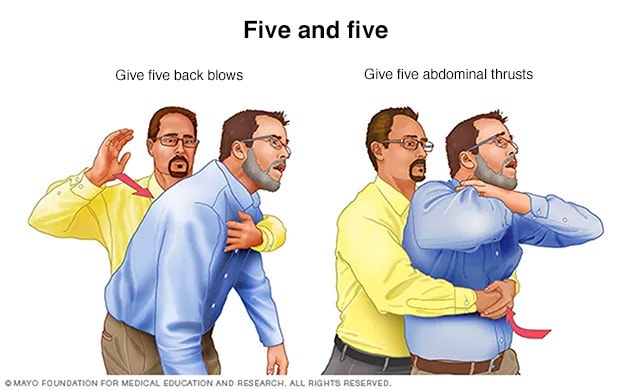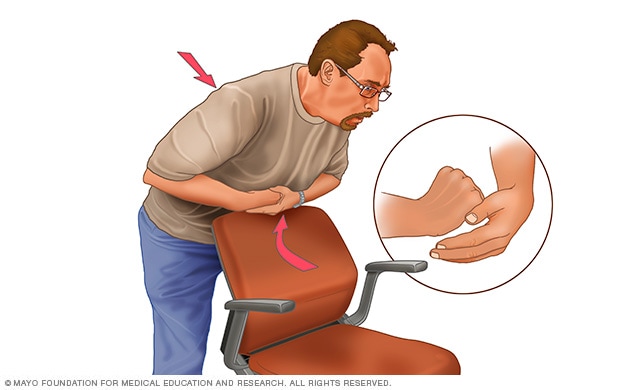First aid for a choking person
First aid for a choking person

First aid for a choking person
If a person is choking and cannot talk, cry or laugh forcefully, give five back blows and then five abdominal thrusts.
How to perform abdominal thrusts, also called the Heimlich maneuver, on yourself
How to perform abdominal thrusts, also called the Heimlich maneuver, on yourself

How to perform abdominal thrusts, also called the Heimlich maneuver, on yourself
To perform abdominal thrusts, also called the Heimlich maneuver, on yourself, place a fist slightly above your navel. Grasp your fist with the other hand and bend over a hard surface. Shove your fist inward and upward.
Choking happens when an object lodges in the throat or windpipe blocking the flow of air. In adults, a piece of food is usually to blame. Young children often choke on small objects. Choking is life-threatening. It cuts off oxygen to the brain. Give first aid as quickly as possible if you or someone else is choking.
Watch for these signs of choking:
- One or both hands clutched to the throat
- A look of panic, shock or confusion
- Inability to talk
- Strained or noisy breathing
- Squeaky sounds when trying to breathe
- Cough, which may either be weak or forceful
- Skin, lips and nails that change color turning blue or gray
- Loss of consciousness
If a choking person can cough forcefully, let the person keep coughing.
Coughing might naturally remove the stuck object.
If a person can’t cough, talk, cry or laugh forcefully, give first aid to the person.
The American Red Cross recommends the following steps:
- Give five back blows. Stand to the side and just behind a choking adult. For a child, kneel down behind. Place your arm across the person’s chest to support the person’s body. Bend the person over at the waist to face the ground. Strike five separate times between the person’s shoulder blades with the heel of your hand.
- Give five abdominal thrusts. If back blows don’t remove the stuck object, give five abdominal thrusts, also known as the Heimlich maneuver.
- Alternate between five blows and five thrusts until the blockage is dislodged.
Some sources only teach the abdominal thrust. It’s OK not to use back blows if you haven’t learned the back-blow technique. Both approaches are acceptable for adults and children older than age 1.
To give abdominal thrusts to someone else:
- Stand behind the person. For a child, kneel down behind. Place one foot slightly in front of the other for balance. Wrap your arms around the waist. Tip the person forward slightly.
- Make a fist with one hand. Put it just above the person’s navel.
- Grasp the fist with the other hand. Press into the stomach, also called the abdomen, with a quick, upward thrust — as if trying to lift the person up. For a child, use gentle yet firm pressure to avoid damaging the internal organs.
- Give five abdominal thrusts. Check if the blockage has been removed. Repeat as needed.
If you’re the only rescuer, give back blows and abdominal thrusts first. Then call 911 or your local emergency number for help. If another person is there, have that person call for help while you give first aid.
If the person becomes unconscious, start standard cardiopulmonary resuscitation (CPR) with chest compressions and rescue breaths.
If the person is pregnant or if you can’t get your arms around the stomach, give chest thrusts:
- Put your hands at the base of the breastbone, just above the joining of the lowest ribs.
- Press hard into the chest with a quick thrust. This is the same action as the Heimlich maneuver.
- Repeat until the blockage is removed from the airway.
To clear the airway of an unconscious person:
- Lower the person onto the floor, with the back on the floor and arms to the sides.
- Clear the airway. If you can see the object, reach a finger into the mouth to sweep out the object. Never finger sweep if you can’t see the object. You risk pushing the blockage deeper into the airway. This is very risky with young children.
- Begin CPR if the person still doesn’t respond. If the airway is still blocked, use chest compressions such as those that are used in CPR to remove the stuck object. Only use two rescue breaths per cycle. Recheck the mouth regularly for the object.
To clear the airway of a choking infant younger than age 1:
- Sit and hold the infant facedown on your forearm. Rest your forearm on your thigh. Hold the infant’s chin and jaw to support the head. Place the head lower than the trunk.
- Thump the infant gently but firmly five times on the middle of the back. Use the heel of your hand. Point your fingers up so that you don’t hit the back of the infant’s head. Gravity and the back thumps should release the blockage.
- Turn the infant faceup on your forearm if breathing hasn’t started. Rest your arm on your thigh. Place the infant’s head lower than the trunk.
- Give five gentle but firm chest compressions with your fingers. Place two fingers just below the nipple line. Press down about 1 1/2 inches. Let the chest rise between each compression.
- Repeat the back thumps and chest compressions if breathing doesn’t start. Call for emergency medical help.
- Begin infant CPR if the airway is clear but the infant doesn’t start breathing.
If you’re alone and choking:
Call 911 or your local emergency number right away. Then, give yourself abdominal thrusts, also called the Heimlich maneuver, to remove the stuck object.
- Place a fist slightly above your navel.
- Grasp your fist with the other hand.
- Bend over a hard surface. A countertop or chair will do.
- Shove your fist inward and upward.
To prepare yourself for these situations, learn the Heimlich maneuver and CPR in a certified first-aid training course.
From Mayo Clinic to your inbox
Sign up for free, and stay up to date on research advancements, health tips and current health topics, like COVID-19, plus expertise on managing health.
To provide you with the most relevant and helpful information, and understand which
information is beneficial, we may combine your email and website usage information with
other information we have about you. If you are a Mayo Clinic patient, this could
include protected health information. If we combine this information with your protected
health information, we will treat all of that information as protected health
information and will only use or disclose that information as set forth in our notice of
privacy practices. You may opt-out of email communications at any time by clicking on
the unsubscribe link in the e-mail.
Thank you for subscribing!
You’ll soon start receiving the latest Mayo Clinic health information you requested in your inbox.
Sorry something went wrong with your subscription
Please, try again in a couple of minutes
Oct. 11, 2022
Products and Services
.
Stay connected with us on social media platform for instant update click here to join our Twitter, & Facebook
We are now on Telegram. Click here to join our channel (@TechiUpdate) and stay updated with the latest Technology headlines.
For all the latest Health News Click Here
For the latest news and updates, follow us on Google News.
